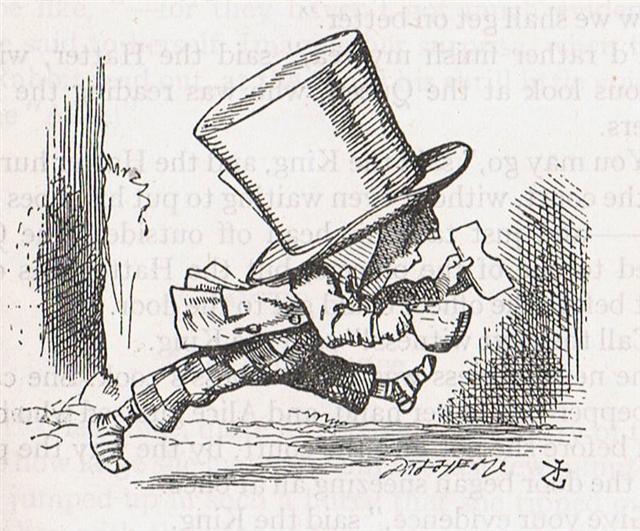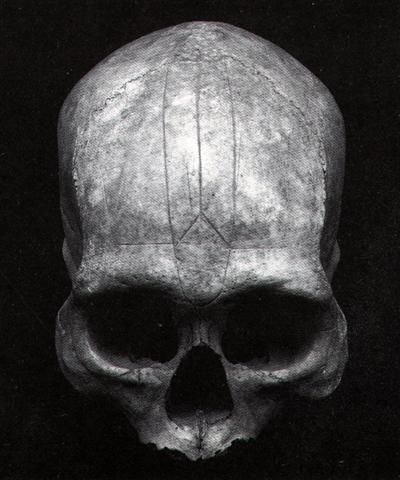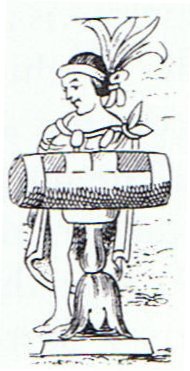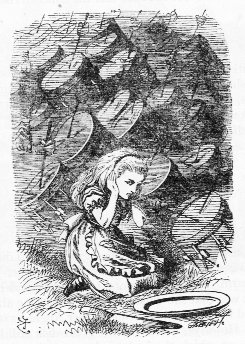Once again. Mercury was visible only seldom and at that time always close to the horizon. ... Ganz ähnlich is der Name 'Gott von Duazag' des Gottes Nabū ... zu erklären. Er bezeichnet ihn als den Gott des Wachtstums, welches als aus dem Osten stammend betrachtet wird, weil die Sonne, die das Wachstum bringt, im Osten aufgeht. Dass aber Nabū als Ost-Gott aufgefasst wurde, hängt damit zusammen, dass sein Stern, der Mercur, nur im Osten oder Westen sichtbar ist ... Therefore he was close to both the Sky Father and to his Mother. He was in contact with both of them. He was not like the other planets, the other metals, because he was fluid in character. I.e., he had not matured enough to decidedly become either a male or a female, he was as yet unstable.
... Mercury was used in the process of curing pelts for hats, making it impossible for hatters to avoid inhaling the mercury fumes given off during the hat making process; hatters and mill workers thus often suffered mercury poisoning, causing neurological damage, including confused speech and distorted vision ...
The dark night (29) of the Moon was associated with Mercury (Hiro).
This important celestial character was close not only to his 'place of birth' (Mother Earth) but also to his radiant Sky Father (Jus Piter). When he was close to the horizon in the west this could be interpreted as an omen of death, of the end (oti).
From glyph 465 (on side b) to the end of the B tablet there are 48 - 8 = 506 - 464 = 41 glyphs (probably equal to 41 right ascension days), and the idea was presumably to suggest the precessional time depth down to Bharani (the Bearer of the Child) - i.e. to the position of birth for a new Sun year (at the beginning of side a of the B tablet).
At the end of side b on the G tablet we can observe how the glyph at heliacal Bharani has been drawn identical with that at the end:
Puo. (Also pu'a); pu'o nua, one who covers himself with a nua (blanket), that is to say, a human being. Vanaga. 1. To dress, to clothe, to dress the hair; puoa, clothed; puoa tahaga, always dressed. 2. To daub, to besmear (cf. pua 2); puo ei oone, to daub with dirt, to smear. 3. Ata puo, to hill up a plant. Churchill. From ma to rutu (Bb11-40) to the end of side b there are 48 (= 7 + 41) glyphs, maybe suggesting the nighttime for from ancient times there were 48 constellations: ... Ptolemy scientifically followed with those now known as the ancient forty-eight, in the 7th and 8th books of the Syntaxis, twelve of the zodiac with twenty-one northern and fifteen southern, made up by 1028 stars, including 102 αμόρφωτοι, all probably from Hipparchos, although with some acknowledged alterations by himself ...
Oti. To come to an end; to suffice, to be enough: ku-oti-á, it is finished; ina kai oti mo kai, there is not enough to eat; he-oti á, there isn't anymore left, it's the last one; it's enough with that. Vanaga. Ta.: 1. Oti, presage of death. Sa.: oti, to die. 2. To cut. Mq.: koti, oti, id. Sa.: 'oti, id. Ma.: koti, id. Churchill.
Bb12-45 → 12 * 45 = 540 = 360 * 1½.
Here we should remember the assembly of toga hand signs in the G text: Toga. 1. Winter season. Two seasons used to be distinguished in ancient times: hora, summer, and toga, winter. 2. To lean against somehing; to hold something fast; support, post supporting the roof. 3. To throw something with a sudden movement. 4. To feed oneself, to eat enough; e-toga koe ana oho ki te aga, eat well first when you go to work. Vanaga. 1. Winter. P Pau., Mgv.: toga, south. Mq.: tuatoka, east wind. Ta.: toa, south. 2. Column, prop; togatoga, prop, stay. Togariki, northeast wind. Churchill. Wooden platform for a dead chief: ka tuu i te toga (Bb8-42), when the wooden platform has been erected. Barthel 2. The expressions Tonga, Kona, Toa (Sam., Haw., Tah.), to indicate the quarter of an island or of the wind, between the south and west, and Tokelau, Toerau, Koolau (Sam., Haw., Tah.), to indicate the opposite directions from north to east - expressions universal throughout Polynesia, and but little modified by subsequent local circumstances - point strongly to a former habitat in lands where the regular monsoons prevailed. Etymologically 'Tonga', 'Kona', contracted from 'To-anga' or 'Ko-ana', signifies 'the setting', seil. of the sun. 'Toke-lau', of which the other forms are merely dialectical variations, signifies 'the cold, chilly sea'. Fornander.
And finally, we have the common denominator te pahu (in all three texts) which could refer to some kind of drum.
... The tun glyph was identified as a wooden drum by Brinton (1895, p. 92), and Marshal H. Saville immediately accepted it. Figure 49 [excerpt above] shows the Aztec drum representation relied on by Brinton to demonstrate his point. It was not then known that an ancestral Mayan word for drum was *tun: Yucatec tunkul 'divine drum' (?); Quiche tun 'hollow log drum'; Chorti tun 'hollow log drum' (Wisdom 1940, pp. 175-176) ... Each of the years, called a tun by the Maya, in these dates is composed of 360 days ... Pahu. Drum. Pahu-rutu-roa = Long-beating-drum. Barthel. M. Pahū. Tree gong. Starzecka. Pahu uma, coffin; in modern usage, any sort of jar. Pahupahu = To dig a hole. Vanaga. A trough, barrel, cask, cradle, drum, chest, box; pahu nui, a kettle; pahu oka, a drawer; pahu papaku, coffin; pahu rikiriki, sheath; pahu viriviri, hogshead. Pahupahu, box. Churchill. A trough, barrel, cask, cradle, drum, chest, box; pahu nui, a kettle; pahu oka, a drawer; pahu papaku, coffin; pahu rikiriki, sheath; pahu viriviri, hogshead; pahupahu, box. P Mgv., Ta.: pahu, a drum. Mq.: pahu, a drum, a large cylindrical container. (To.: bahu, a hollow tree set in water as a filter.) Sa.: pusa, a box. To.: buha, id. Fu.: pusa, id. Niue: puha, id. Pau.: puha, id. Pahuahi, lantern, beacon. Paukumi, closet, cupboard. Pahupopo, a mould; pahupopokai, cupboard for food. Pahure: 1. To sweep everything away. 2. To wound, to lacerate, scar, bruise, lesion, sore; pahurehure, to wound, to scratch; hakapahure, to wound. T Pau.: pahure, to be skinned; pahore, to peel off, to scale. Mgv.: pahore, to cut off, to chop, to slice. Ta.: pahore, to flay, to skin. Churchill 2. ... Hercules first appears in legend as a pastoral sacred king and, perhaps because shepherds welcome the birth of twin lambs, is a twin himself. His characteristics and history can be deduced from a mass of legends, folk-customs and megalithic monuments. He is the rain-maker of his tribe and a sort of human thunder-storm. Legends connect him with Libya and the Atlas Mountains; he may well have originated thereabouts in Palaeolithic times. The priests of Egyptian Thebes, who called him Shu, dated his origin as '17,000 years before the reign of King Amasis'. He carries an oak-club, because the oak provides his beasts and his people with mast and because it attracts lightning more than any other tree. His symbols are the acorn; the rock-dove, which nests in oaks as well as in clefts of rocks; the mistletoe, or Loranthus; and the serpent. All these are sexual emblems. The dove was sacred to the Love-goddess of Greece and Syria; the serpent was the most ancient of phallic totem-beasts; the cupped acorn stood for the glans penis in both Greek and Latin; the mistletoe was an all-heal and its names viscus (Latin) and ixias (Greek) are connected with vis and ischus (strength) - probably because of the spermal viscosity of its berries, sperm being the vehicle of life. This Hercules is male leader of all orgiastic rites and has twelve archer companions, including his spear-armed twin, who is his tanist or deputy. He performs an annual green-wood marriage with a queen of the woods, a sort of Maid Marian. He is a mighty hunter and makes rain, when it is needed, by rattling an oak-club thunderously in a hollow oak and stirring a pool with an oak branch - alternatively, by rattling pebbles inside a sacred colocinth-gourd or, later, by rolling black meteoric stones inside a wooden chest - and so attracting thunderstorms by sympathetic magic ... ...The basic myth of dynastic Egypt was that of the death and resurrection of Osiris, the good king, 'fair of face' [cfr 'of Roko the Fair'], who was born to the earth-god Geb and sky-goddess Nut. He was born together with his sister-wife, the goddess Isis, during the sacred interval of those five supplementary days that fell between one Egyptian calendric year of 360 days and the next. He and his sister were the first to plant wheat and barley, to gather fruit from trees, and to cultivate the vine, and before their time the races of the world had been savage cannibals. But Osiris's evil brother, Set, whose sister-wife was the goddess Nephtys, was mortally jealous both of his virtue and of his fame, and so, stealthily taking the measure of his good brother's body, he caused a beautifully decorated sarcophagus ['flesh eater'] to be fashioned and on a certain occasion in the palace, when all were drinking and making merry, had it brought into the room and jestingly promised to give it to the one whom it should fit exactly. All tried, but, like the glass slipper of Cinderella, it fitted but one; and when Osiris, the last, laid himself within it, immediately a company of seventy-two [360 / 5] conspirators with whom Set had contrived his plot dashed forward, nailed the lid upon the sarcophagus, soldered it with molten lead [→ Saturn], and flung it into the Nile, down which it floated to the sea ...
|
||||||||||||||||||||||||||||||||||||||||||||||||||||||||||||||||||||||||||||||||||||||||||||||||||||||||||||||||||||||||||||||||||||||||||||||||||||||||||||||||||||












.jpg)











